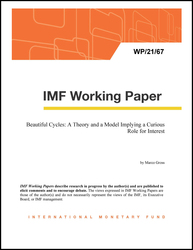
Beautiful Cycles: A Theory and a Model Implying a Curious Role for Interest
Beautiful Cycles: A Theory and a Model Implying a Curious Role for Interest
READ MORE...
Volume/Issue:
Volume 2021
Issue 067
Publication date: March 2021
ISBN: 9781513571676
$18.00
Add to Cart by clicking price of the language and format you'd like to purchase
Available Languages and Formats
| English |
Prices in red indicate formats that are not yet available but are forthcoming.
Topics covered in this book
This title contains information about the following subjects.
Click on a subject if you would like to see other titles with the same subjects.
Labor , Economics- Macroeconomics , Business and financial cycles , , WP , firm profits , price inflation , profit share , interest rate , market power , money stock , Business and financial cycles , full employment , price Phillips curves , Wages , Wage rigidity , Income , Labor share , Loans , Global
Summary
Where do economic cycles come from? This paper contemplates an utmost minimalistic model and underlying theory that rest on two assumptions for letting them emerge endogenously: (1) the presence of interest-bearing debt; and (2) a degree of downward nominal wage rigidity. Despite its parsimony, the model generates well-behaved, self-evolving limit cycles and replicates six essential empirical facts: (1) booms are long- while recessions short-lived; (2) leverage is procyclical; (3) firm profit and wage shares in GDP are counter- and procyclical, respectively; (4) Phillips curves are downward-sloping and convex, and Okun’s law relation is replicated; (5) default cascades arise endogenously at the turning points to recessions; (6) lending spreads are countercyclical. One can refer to the model as being of a Dynamic Stochastic General Disequilibrium (DSGD) kind.
Copyright © 2010 - 2025
Powered by:
AIDC



